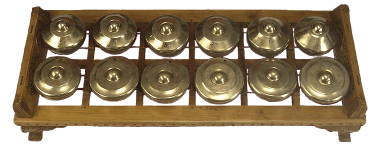The instrument
The bonang consists of a double range of bronze kettles, which are like small gongs with relatively high shoulders, and positioned with the open side downward on a grid-like underframe. In the squares formed by this grid two cords are strung, either parallel or crosswise, to provide a vibrant resting place for the kettles.
In slendro the range is 2x 6 kettles, comprising two octaves plus high tones 1 and 2 (in Yogya frequently 2x 5 kettles, omitting low 1 and highest 2); in pelog the range is 2x 7 kettles, producing 2 complete octaves.

A set of two
The bonangs form a set of two: bonang barung, and bonang panerus which sounds one octave higher. Since the instruments have two octaves, there is an overlap of one octave and two tones between bonang barung and bonang panerus (see diagram of range & notation).
The player sits at the long side of the instrument, with the lowest of the two octaves immediately in front of him, the higher of the two octaves placed in the row behind. The kettles of this upper octave have a slightly higher build than the lower octave kettles.
In slendro the arrangement of the kettles usually is:
| 6 | 5 | 3 | 2 | 1 | 2 |
| 1 | 2 | 3 | 5 | 6 | 1 |
in pelog:
| 4 | 6 | 5 | 2 | 1 | 7 |
| 7 | 1 | 2 | 5 | 6 | 4 |
Playing Technique
The arrangement is such, that the playing of octaves is made easier by moving the hands in mirror symmetry. The hand position shift-point is where the two 3’s are. Since the kettles are placed freely on the cords, players may, and will, vary the order of the kettles according to their convenience and needs.
Volume
When played with force, the bonangs, and the kenongs, are the loudest instruments of the gamelan, comparable to the brass section in an orchestra (followed by the sarons).
Since playing loud takes no special effort (in fact, playing soft is very much harder), they can easily cover the rest of the ensemble, so as a composer you should always keep this in mind.
Slendro & pelog
Sticks
The kettles are made to sound by beating the boss with sticks sporting a cylindrical head wound with cord. The player holds one stick in each hand, so two tones can be produced together at a time. Damping is done by the same wound part of the stick – the player must take care to do this as inaudible as possible. This is of course less critical when the next tone is sounded simultaneously. As long as the hands of the player alternate regularly, a fair speed may be achieved in runs, but as a composer you must keep in mind that the distances between kettles not lying next to each other are considerable, and will slow down the movement accordingly.
Kecekan-technique
Besides hitting the boss of the kettle in the usual way, one can also hit the flat surface surrounding the boss. This is done with the end of the stick (i.e. the unwound, wooden part), which produces a rather brassy sound. This technique (called kecekan) is used on the reyong, the Balinese counterpart of the bonang, and it is a welcome addition to the sound palette of the instrument. It can either be played ‘open’ (i.e. laissez vibrer), or ‘closed’ (muted, by letting the stick rest on the surface). It can also be alternated with muting by the other hand.
In western music script, open is notated as o over the note to played, closed as ø.



